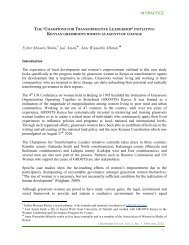The Cluster Initiative Greenbook
The Cluster Initiative Greenbook
The Cluster Initiative Greenbook
Create successful ePaper yourself
Turn your PDF publications into a flip-book with our unique Google optimized e-Paper software.
Research and<br />
networking<br />
<strong>Cluster</strong><br />
expansion<br />
Policy<br />
action<br />
Innovation and<br />
technology<br />
Commercial<br />
cooperation<br />
Education<br />
and training<br />
Figure 3<br />
<strong>The</strong> <strong>Cluster</strong> <strong>Initiative</strong> Target<br />
Board<br />
• Almost all CIs (89%) have a dedicated facilitator, and many (68%) have some sort of<br />
office. <strong>Cluster</strong> facilitators tend to have an industry background from the cluster.<br />
• Many (78%) spend time and efforts to build a framework of shared ideas about<br />
why the CI is beneficial and how it is supposed to work. This framework is usually<br />
(87%) based on an evaluation of the cluster’s own strength and capabilities, and<br />
more rarely (36%) is an international blueprint adopted. CIs tend to have an explicitly<br />
formulated vision (84%), but less (68%) also have quantified targets for their<br />
activities. 83% reach some level of consensus about what activities to perform.<br />
• 95% of CIs have ten active members or more. 40% depend for their future success<br />
on one key individual.<br />
Characteristics of successful CIs<br />
• 85% agree that the CI has improved the competitiveness of the cluster, and 89%<br />
have helped the cluster grow. Overall, 81% of CIs have met their goals, while only<br />
4% have been disappointing and not led to much change.<br />
• <strong>The</strong> national social, political and economic setting within which CIs are implemented<br />
is important for the performance. Key factors include a high level of company trust<br />
in government initiatives and having influential local government decision makers,<br />
which are both clearly related to good CI performance.<br />
• CIs serving strong cluster of national and regional importance are more successful.<br />
• CIs initiated through a competition process to get government financing perform<br />
significantly better in terms of increasing international competitiveness. CIs for clusters<br />
in areas designated by government as attractive perform significantly better in<br />
attracting new firms.<br />
• <strong>The</strong>re is no effect on performance if government picks the companies to involve in<br />
the CI. Nor do CIs with members within one hour’s travel distance, in a single level<br />
of the value chain, or avoiding direct competitors or small companies perform<br />
better. CIs limited to domestic companies perform worse.<br />
• CIs with offices and budgets sufficient to conduct significant projects without seeking<br />
separate funding perform better. For promoting cluster growth, establishing an<br />
exchange with other clusters in the same industry is beneficial.<br />
• For the facilitator, having a broad network of contacts is the most important success<br />
factor, but the facilitator’s qualities are more importance for competitiveness<br />
performance than for growth performance.<br />
Setting<br />
Objectives<br />
Process<br />
Performance<br />
<strong>The</strong> <strong>Cluster</strong> <strong>Initiative</strong> <strong>Greenbook</strong> • 11

















